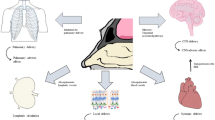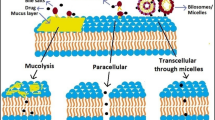Abstract
Purpose
The use of intestinal permeation enhancers to overcome the absorption challenges associated with oral drug delivery has been hampered by the notion that enhancer efficacy is directly linked to toxicity. This study attempts to gain insight into the principles governing the potency and toxicity behavior of enhancers.
Methods
Fifty-one enhancers were selected from 11 chemical categories and their potency and toxicity were analyzed in Caco-2 monolayers at concentrations spanning three orders of magnitude.
Results
A small but significant fraction of the 153 enhancer formulations studied demonstrated unexpected but desired behavior, that is, substantial efficacy without marked toxicity. Our results revealed that both chemical category and concentration proved critical in determining the usefulness of many enhancers, and the concept of an enhancer’s ‘therapeutic window’ is discussed. Several of the most promising enhancers identified by the study were tested for their effect on the transport of the marker molecules mannitol and 70 kDa dextran across Caco-2 cells and were capable of increasing permeability more than 10-fold.
Conclusions
The results presented here underscore the potential of chemical permeation enhancers while providing valuable direction as to what classes and concentrations of compounds are of interest when searching for safe and effective additions to oral formulations.




Similar content being viewed by others
Abbreviations
- AS:
-
anionic surfactant
- BS:
-
bile salt
- CPE:
-
chemical permeation enhancer
- CS:
-
cationic surfactant
- DMEM:
-
Dulbecco’s Modified Eagles Medium
- EP:
-
enhancement potential
- FA:
-
fatty acid
- FE:
-
fatty ester
- FM:
-
fatty amine
- MTT:
-
methyl thiazole tetrazolium
- NR:
-
nitrogen-containing ring
- NS:
-
nonionic surfactant
- OP:
-
overall potential
- OT:
-
other
- PPZ:
-
phenyl piperazine
- SDC:
-
sodium deoxycholate
- SLA:
-
sodium laureth sulfate
- SOA:
-
sodium salt of oleic acid
- SS:
-
sodium salt of fatty acid
- TEER:
-
transepithelial electrical resistance
- TP:
-
toxicity potential
- ZS:
-
zwitterionic surfactant
References
M. Goldberg, and I. Gomez-Orellana. Challenges for the oral delivery of macromolecules. Nat. Rev. Drug Discov. 2:289–295 (2003).
G. Mustata, and S.M. Dinh. Approaches to oral drug delivery for challenging molecules. Crit. Rev. Ther. Drug Carrier Syst. 23:111–135 (2006).
L. Serra, J. Domenech, and N. A. Peppas. Drug transport mechanisms and release kinetics from molecularly designed poly(acrylic acid-g-ethylene glycol) hydrogels. Biomaterials. 27:5440–5451 (2006).
S. L. Tao, and T. A. Desai. Gastrointestinal patch systems for oral drug delivery. Drug Discov. Today. 10:909–915 (2005).
B. J. Aungst. Intestinal permeation enhancers. J. Pharm. Sci. 89:429–442 (2000).
N. N. Salama, N. D. Eddington, and A. Fasano. Tight junction modulation and its relationship to drug delivery. Adv. Drug Deliv. Rev. 58:15–28 (2006).
D. Bourdet, G. Pollack, and D. Thakker. Intestinal absorptive transport of the hydrophilic cation ranitidine: a kinetic modeling approach to elucidate the role of uptake and efflux transporters and paracellular vs. transcellular transport in Caco-2 Cells. Pharm. Res. 23:1178–1187 (2006).
E. S. Swenson, W. B. Milisen, and W. Curatolo. Intestinal permeability enhancement: efficacy, acute local toxicity, and reversibility. Pharm Res. 11:1132–1142 (1994).
R. Konsoula, and F. A. Barile. Correlation of in vitro cytotoxicity with paracellular permeability in Caco-2 cells. Toxicol. In Vitro. 19:675–684 (2005).
P. Karande, A. Jain, and S. Mitragotri. Relationships between skin's electrical impedance and permeability in the presence of chemical enhancers. J. Control. Rel. 110:307–313 (2006).
M. Tomita, M. Hayashi, and S. Awazu. Absorption-enhancing mechanism of EDTA, caprate, and decanoylcarnitine in Caco-2 cells. J. Pharm. Sci. 85:608–611 (1996).
E. Fuller, C. Duckham, and E. Wood. Disruption of epithelial tight junctions by yeast enhances the paracellular delivery of a model protein. Pharm. Res. 24:37–47 (2007).
E. S. Swenson, and W. Curatolo. Intestinal permeability enhancement for proteins, peptides, and other polar drugs: mechanisms and potential toxicity. Adv. Drug Deliv. Rev. 8:39–92 (1992).
N. Frank, H. Achim, S.-H. Georg von, and M. Heinz. Synergistic action of a cyclic depsipeptide and piperazine on nematodes. Pharm. Res. 86:982–992 (2000).
J. S. Warrington, L. L. Von Moltke, J. S. Harmatz, R. I. Shader, and D. J. Greenblatt. The effect of age on sildenafil biotransformation in rat and mouse liver microsomes. Drug Metabol. Dispos. 31:1306–1309 (2003).
M. J. Fray, G. Bish, P. V. Fish, A. Stobie, F. Wakenhut, and G. A. Whitlock. Structure-activity relationships of N-substituted piperazine amine reuptake inhibitors. Bioorg. Med. Chem. Lett. 16:4349–4353 (2006).
K. Whitehead, Z. Shen, and S. Mitragotri. Oral delivery of macromolecules using intestinal patches: applications for insulin delivery. J. Control. Rel. 98:37–45 (2004).
E. Duizer, C. Van Der Wulp, C. H. M. Versantvoort, and J. P. Groten. Absorption enhancement, structural changes in tight junctions and cytotoxicity caused by palmitoyl carnitine in Caco-2 and IEC-18 cells. J. Pharmacol. Exp. Ther. 287:395–402 (1998).
S. Takatsuka, T. Kitazawa, T. Morita, Y. Horikiri, and H. Yoshino. Enhancement of intestinal absorption of poorly absorbed hydrophilic compounds by simultaneous use of mucolytic agent and non-ionic surfactant. Eur. J. Pharm. Biopharm. 62:52–58 (2006).
K. Lindhardt, and E. Bechgaard. Sodium glycocholate transport across Caco-2 cell monolayers, and the enhancement of mannitol transport relative to transepithelial electrical resistance. Int. J. Pharm. 252:181–186 (2003).
T. Lindmark, T. Nikkila, and P. Artursson. Absorption enhancement through intracellular regulation of tight junction permeability by medium chain fatty acids in Caco-2 cells. J. Pharmacol. Exp. Ther. 284:362–369 (1998).
R. B. Shah, A. Palamakula, and M. A. Khan. Cytotoxicity evaluation of enzyme inhibitors and absorption enhancers in Caco-2 cells for oral delivery of salmon calcitonin. J. Pharm. Sci. 93:1070–1082 (2004).
M. A. Radwant, and H. Y. Aboul-Enein. The effect of oral absorption enhancers on the in vivo performance of insulin-loaded poly(ethylcyanoacrylate) nanospheres in diabetic rats. J. Microencapsul. 19:225–235 (2002).
Acknowledgements
This work was supported by a fellowship to KW from the Graduate Research and Education in Adaptive bio-Technology (GREAT) Training Program by the University of California Biotechnology Research and Education Program and by the American Diabetes Association.
Author information
Authors and Affiliations
Corresponding author
Electronic supplementary material
Below is the link to the electronic supplementary material.
Table SI
Macroscopic Property Data for all CPEs (DOC 193 kb)
Rights and permissions
About this article
Cite this article
Whitehead, K., Karr, N. & Mitragotri, S. Safe and Effective Permeation Enhancers for Oral Drug Delivery. Pharm Res 25, 1782–1788 (2008). https://doi.org/10.1007/s11095-007-9488-9
Received:
Accepted:
Published:
Issue Date:
DOI: https://doi.org/10.1007/s11095-007-9488-9




